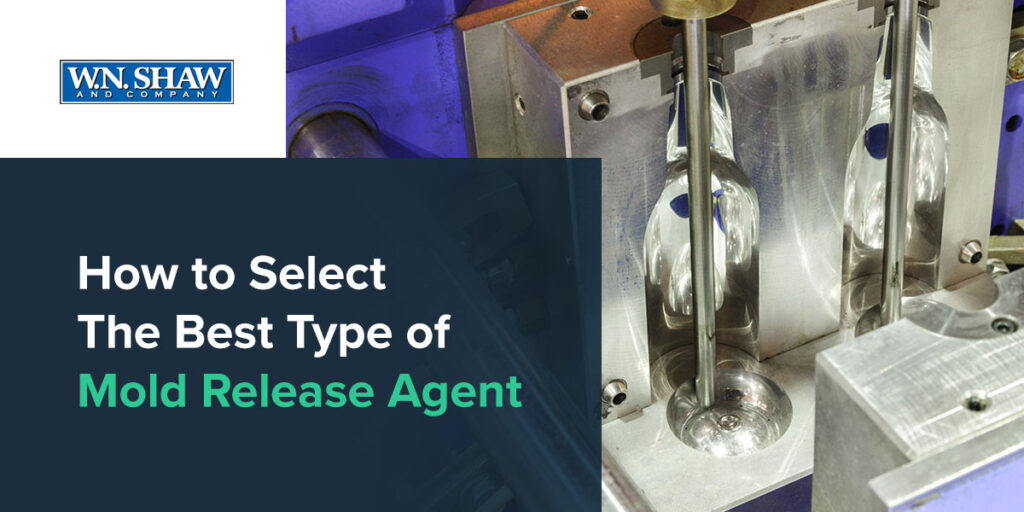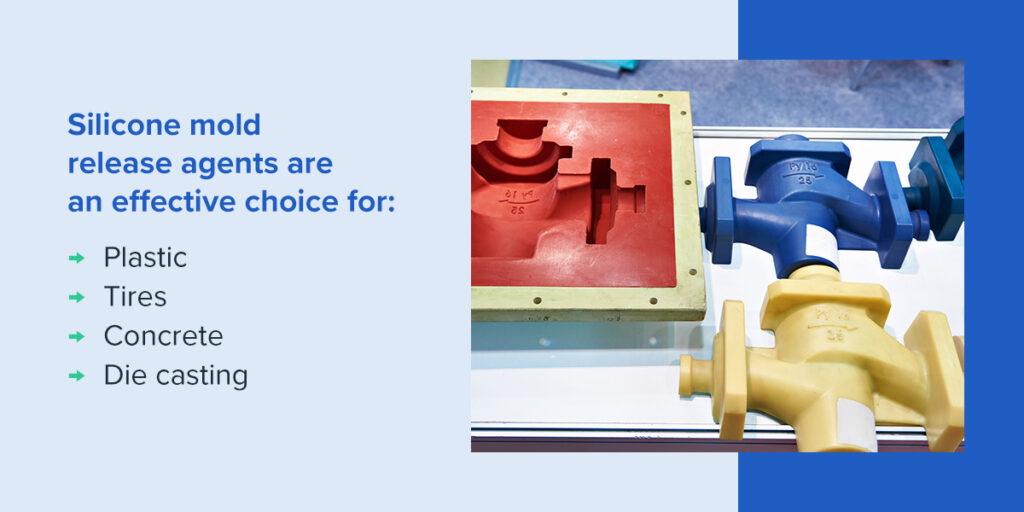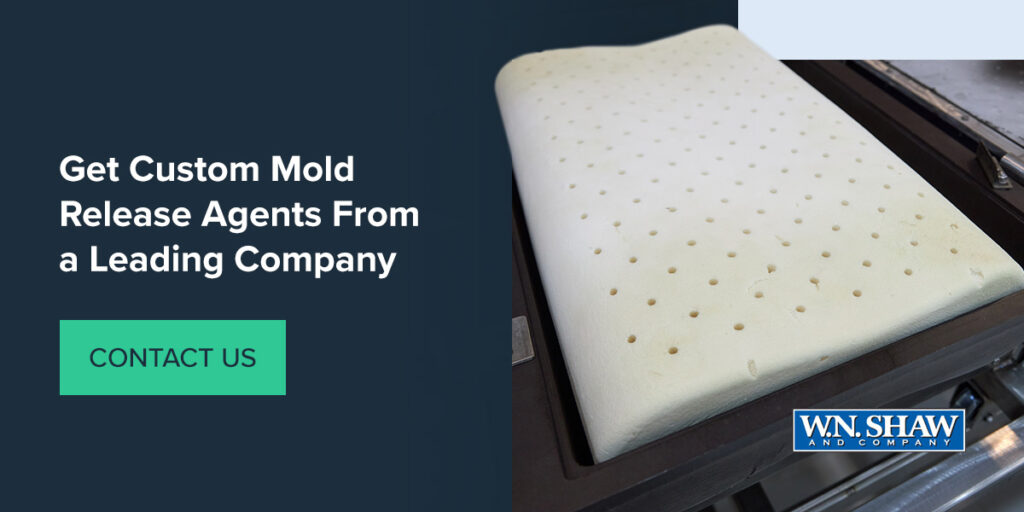How to Select The Best Type of Mold Release Agent

Whether you work in the medical, construction, electronic, automotive or food and beverage industry, it’s essential to produce your products quickly. Many parts and products in these industries are made with molds, from shoes to insulation panels to wind turbine blades. While molds enable fast, uniform production, sticking parts can cause excess debris that damages your machine and products.
Sticking parts can become damaged, deformed or blemished, impacting your cycle times and cutting into your profits. A mold release agent provides a solution to these issues, acting as a lubricant coating to prevent your products or parts from sticking to the mold. These agents are a simple way to extend the life of your molds, prevent sticking pieces and minimize resin buildup.
Different Types of Mold Release Agents
Mold release agents perform the critical task of preventing materials from bonding to a mold. They also help reduce production time, improve cleanup procedures and increase the mold’s life span. Many different types of mold release formulas on the market are useful for industrial applications. Here are the most common ones.
Water-Based Mold Release Agents
Water-based mold release agents use water as their primary component. These agents require extensive research and have complex development processes. Though water-based mold release agents are more challenging to formulate, they provide a smoother release from molds and minimize the occurrence of damage. These agents also pose less of a health and safety risk than solvent-based mold release agents.
Water-based agents’ excellent release ease and surface and finish properties make them useful in multiple applications. Some of the advantages of water-based mold release agents include:
- Reduced buildup and mold fouling.
- Environmental advantages over petroleum agents thanks to a lack of harsh chemicals like volatile organic compounds (VOCs).
- Versatility to use them in a diluted or concentrated form.
This type of mold release agent is most suitable for concrete molds, which often work better with water.
Solvent-Based Mold Release Agents
Solvent-based mold release agents contain chemical materials such as refined petroleum to enhance mold release with polymers, rubbers and metals. These agents require fewer complex processes to create. They produce high-quality, fast-drying results that can lead to increased productivity and reduced production costs.
Solvent-based mold release agents are compatible with a wide range of applications in many different industries. While some of these agents contain VOCs, they are also generally less expensive and easier to manufacture due to their simple technology. Solvent mold releases are also easy to apply and facilitate strong film formation.
Silicone Mold Release Agents
Silicone mold release agents are an effective choice for many different releases, including:
- Plastic
- Tires
- Concrete
- Die casting
Silicone mold releases have lower use rates than some alternatives and generally produce a cleaner finished product. They also provide fast release, low material waste and a longer life span for the mold and machinery, leading to increased savings over time. Silicone mold release agents serve many industries, including construction, athletics, medical and footwear. These industries benefit from silicone agents’:
- Exceptional oxidation resistance.
- Higher heat stability than organic alternatives.
- Reduced surface tension.

Silicone-Free Mold Release Agents
Silicone-free mold release agents are perfect for applications where it’s necessary to remove silicone from the mold release process. Using a non-silicone product can minimize the risk with post-molding operations where silicone may have presented a problem. Silicone-free — or non-silicone release agents — support part removal and molding processes, like injection. They work with many different types of materials used for molding, such as:
- Rubber
- Polyurethanes
- Plastics
- Composite materials
However, these agents are also suitable for working with materials like concrete, stone and wood. Some benefits of silicone-free mold release agents include:
- Compatibility with electrical components.
- Specific food-safe formulas.
- Effective release properties.
- Support for decorations such as painting, labeling or bonding.
- Increased part appearance and removal frequency.
What to Consider When Choosing a Mold Release Agent
Finding the proper mold release formula for your products can be challenging with so many different agents available. Here are some things to keep in mind to help you choose the right mold release agent.
Choosing the Right Universal Release Agent
Rather than having several different release agents on hand, choosing a universal release agent can streamline your processes and make mold release more efficient. While some all-purpose mold release agents may use milder chemicals with a longer release time, it can be easier to use the same compound on all your products.
A universal release agent will also help you avoid part contamination by maintaining the same chemical and material interactions with every application.
Choosing a Mold Agent for When Adhesion Is Important
The purpose of a mold release agent is to control or eliminate the adhesion between a mold surface and your product. However, the release agent needs its own adhesion to remain on the mold surface. Minimal adhesion will ensure a continuous release with each application.
Surface adhesion provides more durability for the product and helps the thin film remain without causing buildup and increasing the number of releases per application. If post-molding adhesion or bonding is critical for your parts or products, mold release agents containing Polytetrafluoroethylene (PTFE) are a good choice. If the molded parts need to be decorated or painted afterward, it’s best to use a water-based or solvent mold release agent.
The Best Mold Release Agents for Quick Releases
If your goal is to significantly reduce release time and move your products along faster, it’s best to choose a fast-drying formula. Mold release agents that dry quickly on cold and hot molds allow you to move on to the next molding process immediately.
The best mold release agents for quick releases and fast turnarounds include silicone-free and solvent-based agents. However, some silicone formulas can also work for a smooth, dry film finish.
Mold Release Formulas for Food-Related Parts
If you work in the food and beverage industry, you’ll likely use or produce many different appliances, utensils, containers and other products that come in contact with consumables, including:
- Blenders
- Ice cube trays
- Spatulas and plastic utensils
- Coffee brewers
Consequently, you’ll need to follow strict performance and output standards. Food-grade mold release agents are an essential component of meeting industry and regulatory standards, such as those set by the FDA. These agents also help you maintain durable and safe tools that meet your operational needs.
Get Custom Mold Release Agents From a Leading Company

Mold releases can prevent potential damage to your parts, products and machines and increase your production capability. However, with so many different options, it can be difficult to determine the best mold release agent for your specific needs and application.
At W.N. Shaw, we have the experience and knowledge to understand the unique challenges and requirements many industries face. We specialize in finding solutions for manufacturers facing mold release agent problems and offer custom formulations for every client’s application needs.
If you’re looking for a solution to reduce your product and part damage due to difficult mold release, contact us online to learn more about our innovative, advanced products.
